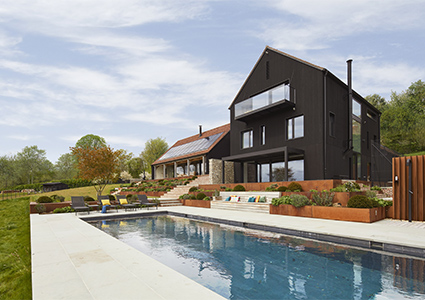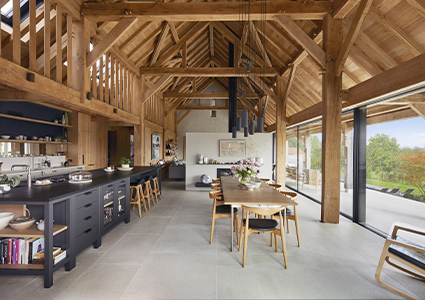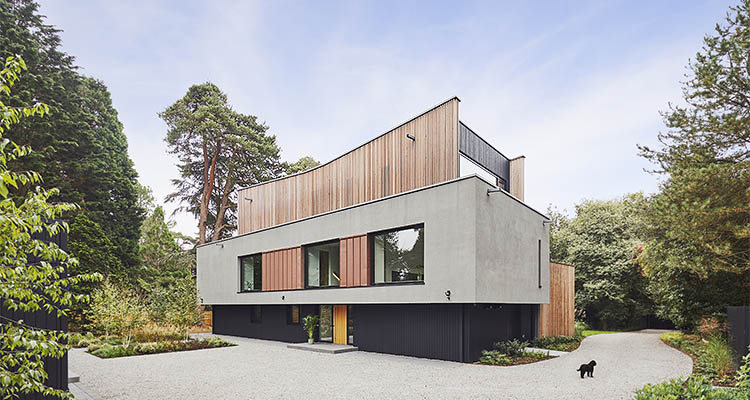How Baufritz Builds Healthier Homes, Naturally
Baufritz’s homes truly stand apart from the crowd; not only are they unique in their individuality and architectural style, but also because of the craft, quality, and ingenuity involved in the design. Rooted in Germany, Baufritz is a fourth-generation family business building sustainable homes that benefit both people and planet.
At a time when others in the industry were not considering sustainable materials and environmentally conscious practices, Baufritz had to adapt, using its innovative core to develop products and materials in-house, including paints, render, insulation, and lighting. With more than 40 exclusive patents, the company develops its own solutions to replace chemical and contaminated products with truly sustainable and natural alternatives. 
“Baufritz began in 1896 near Bavaria in Germany as a firm of carpenters, at a time and place when buildings were predominantly constructed using timber,” begins Oliver Rehm, CEO. “In a rural area surrounded by forest, we constructed agricultural buildings and completed work for local churches, as well as producing some prefabricated parts, although not to the extent we are today. Having worked on several small-scale projects, we expanded into building houses in the 1920s, starting with log cabins and simple structures. Over the years, we’ve evolved into a high-tech, off-site timber manufacturing business producing traditional buildings and architecture.
“From the 1980s onwards, we shifted our focus to ecological and healthy building practices. The owner at the time recognised that most buildings were made with materials containing chemicals and contemplated the negative impact this could have on the inhabitants’ health. Determined to change this, the company pivoted to build as naturally as possible, using environmentally friendly and chemical-conscious products to create visually stunning, healthy homes.
“As the climate crisis has worsened, more and more people have realised the need for environmentally friendly buildings, and our methods have become an important concept across the construction industry. However, our research and development activities never stop, as there are constant developments that we must incorporate to continuously evolve how we build with the environment in mind.”
Rethinking materials
Having witnessed the business go through several iterations, Oliver offers his insight into how demand for sustainable building solutions has evolved in recent years. “The 1980s was the start of the green movement in Germany, with people changing their lifestyles and thinking more consciously about the food we eat and the energy we use,” he shares. “However, these changes take decades to come to fruition, especially the global energy transition, with Germany turning off its last nuclear power station just last year.
“During this long process of transforming energy provisions, society has shifted to adopt more sustainable solutions in all aspects of life. In terms of construction and our decision to prioritise chemical-free materials, we stopped using timber that had been treated with chemical preservatives. While we use gloves and goggles for health and safety measures, our intention is to provide materials that can be handled on construction sites without the need for extensive protection measures like masks.
“Perhaps the biggest challenge associated with eliminating chemicals is what to do if the market doesn’t offer natural materials,” Oliver reflects. “The market was, and still is, largely dominated by artificial or composite materials, so we decided to develop our own products. It was a long transition, but today, the industry has caught up with demand, especially in Germany and the UK, meaning standard sustainable alternatives are more widely available. People began to understand that by using natural materials, you reduce a project’s energy consumption as they require much less energy during production than chemical materials. Most natural materials are also recyclable or biodegradable too, enhancing the circularity of a project.
“It’s a strange concept really; we’re almost going back in time to adopt historical building methods. This is how things were built years ago, using whatever recycled materials people could find to create a structure without any kind of chemical involvement. However, we must also be mindful that humans have destroyed many natural resources, and we need to play a part in regenerating these. Prefabrication is an ideal solution, as it uses a combination of traditional methods and high-tech machinery to process natural materials in a precise way within a controlled factory environment.”
Wide ranging services
 Turning to operations, Oliver continues: “We offer a wide selection of products to suit all lifestyles and preferences, but all components we produce are always of the same, high-quality standards. Whether it’s a large house or a commercial building, we pride ourselves on providing the best products on the market in terms of ecology and health.
Turning to operations, Oliver continues: “We offer a wide selection of products to suit all lifestyles and preferences, but all components we produce are always of the same, high-quality standards. Whether it’s a large house or a commercial building, we pride ourselves on providing the best products on the market in terms of ecology and health.
“Our detached houses range from rather small and simple to large and complex bespoke homes, and we also work on commercial buildings if the demand is there, such as work for local authorities or companies that want to invest in an ecological office. We sometimes deal with multiple dwellings, most often small-scale apartment blocks, but as timber is still restricted in most areas, we can only construct low-rise buildings up to four stories high. We’ve also previously developed small eco villages, which are communities of around 12-to-14 houses where like-minded people come together to live as naturally and ecologically as possible.
“Our services also include house extensions as well as complete refurbishments, and in the past, we’ve completed a new extension but upgraded the rest of the building both internally and externally. We can install a new roof or windows, for example, as well as internal systems like electrical, heating, HVAC, and ventilation. There are so many old buildings in a poor state, but we can upgrade and modernise them by implementing our façade and roofing systems, which can also be added to larger buildings like apartment blocks.”
Selective expansion
Next, our conversation turns to how Baufritz had expanded around the globe. “Germany is surrounded by lots of countries, and Baufritz naturally began to export products to neighbouring countries like Switzerland, Austria, Luxembourg, and Belgium, but our biggest export market for the last 20 years has been the UK,” Oliver says. “However, the Covid-19 pandemic changed market conditions dramatically, and we decided to consolidate the business rather than expanding further to ensure we could deliver the quality we pride ourselves on.
“Today, we have our headquarters and main offices in Germany, where we have a strong partner network, and we also have offices and a partner network in the UK. We use local suppliers where possible and we’re very selective with our supply chain to ensure products conform with our specifications and high standards.
“In terms of expansion, the domestic market in Canada is a very interesting space at the moment, with lots of opportunities for prefabrication companies,” he shares. “It could be the right time for us to reignite a former relationship in the Canadian market, so we are in conversation with manufacturers to explore how we could enter Canada.”
Commenting on the future of the business, Oliver concludes: “I’d like to see us providing a more diverse offering and expanding our involvement with the refurbishment and extension of existing buildings. We’ll also strive to make our products more accessible and affordable for a wider range of customers, particularly in the UK market. However, in terms of sustainability, there needs to be a much larger network of connected manufacturers working together on a long-term strategy to positively contribute to the environment.”
